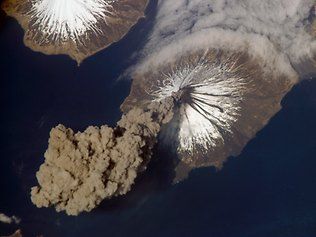
The Cleveland Volcano, located on an uninhabited island 940 miles southwest of Anchorage, had been oozing lava and gas since July.
Ash from the 5,676-foot volcano is considered potentially dangerous to aircraft because Cleveland's peak lies directly below commercial flight routes between Asia and North America.
Additional explosions producing larger ash clouds are possible and could come without warning, the observatory said.
Thursday's explosion, captured by satellite imagery, likely stemmed from a gradual buildup of pressure during months of intermittent low-level eruptions, said Dave Schneider, a geophysicist with the Alaska Volcano Observatory.
The last significant eruption at Cleveland was in 2001, when the volcano unleashed three explosions that spewed ash as high as 39,000 feet, spilled a stream of lava from the summit crater and unleashed an avalanche of molten rock, according to the observatory. Cleveland also erupted in 2009, with smaller ash emissions.
The volcano encompasses about half the uninhabited Chuginadak Island. The nearest human settlement is Nikolski, a tiny Aleut village located about 45 miles to the east.
Although Cleveland is among the most active of Alaska's roughly 90 volcanoes, no seismic equipment or cameras are set up there for continuous monitoring because of its remote location. Scientists keep tabs on the mountain with satellite data, eyewitness reports and video from mariners and pilots in the area.
Cleveland is the only Alaska volcano blamed in an eruption-caused human death in recorded history. A U.S. soldier who was stationed on Chuginadak during World War Two disappeared during an eruption and was presumed killed.



Reader Comments
to our Newsletter